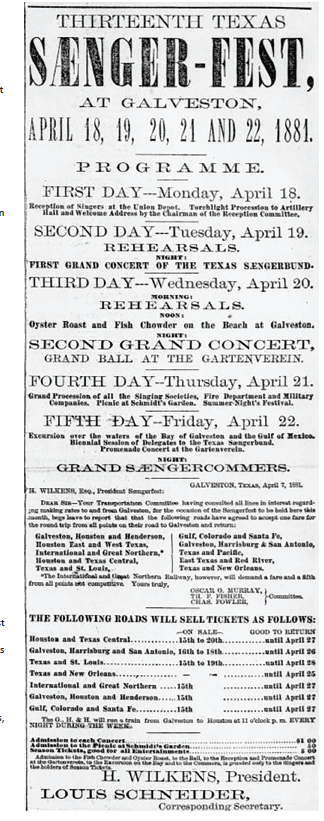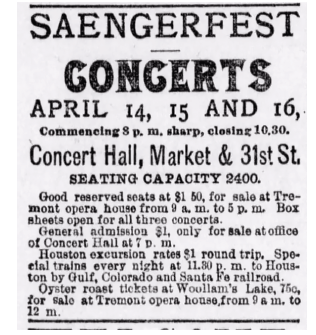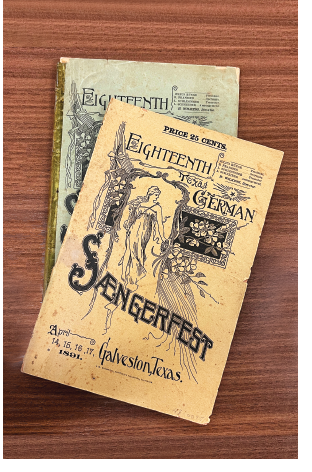Saengerfest Park on The Strand is known as a gathering place for movies, music, food trucks, its large chess board, and as a cheerful place to meet with friends. But many don’t know that it was named for a 19th century German singing contest that holds a unique place in Galveston history.
The first German singing society in Texas was organized in 1845 in New Braunfels with eight singers who would occasionally meet to sing songs from their homeland.
By 1852, German settlers formed similar singing societies in San Antonio and Austin, resulting in the formation of a Saengerbund (singers’ league) which met the following year in New Braunfels to frame a plan for future competitions.
The original participating cities were soon joined by others across the state that had growing German populations.
In addition to presenting an opportunity for the German community to celebrate its heritage, it also provided a platform to voice their views - even if they went against popular sentiment.
At the annual Staats-Saengerfest (State Singer’s Festival) in May 1854, Texas Germans declared slavery to be evil years before the contentious subject would cause the country to erupt in a civil war. That war, and the reconstruction years that followed, caused the first pause in holding Saengerfest from 1861 through 1869.
In the 1870s, an all-male German singing society known as the Salamander Club and the Mendelssohn Society, which included men and women, formed in Galveston under the direction of local businessman Henry H. Wilkens. Weekly practices were held at Casino Hall on Winnie Street, and public performances took place at the Galveston Opera House.
When German immigrant choral societies from across the state participated in a Saengerfest competition in 1879, the Salamanders won first place, earning a silver loving cup and the honor of their hometown’s opportunity to host the event for the first time, during April 19-23, 1881.
Despite the island’s large number of German residents, Fredericksburg and New Braunfels disapproved of the location and broke off to form their own Saengerbund. From that time forward, Saengerfest rotated between San Antonio, Houston, Austin, Galveston, and Dallas every other year.
To commemorate the event, Galveston erected a large structure designed by Nicholas J. Clayton called the Saengerfest Pavilion at 21st Street that could accommodate 5,800 concert attendees. Paid for and owned by the Galveston Railroad Company, it was the first public building to be lit entirely by electricity in the city and was a marvel at the time.
Workmen labored for 18 hours a day for 10 days to construct the building in time for the upcoming event. At midnight on April 16, they turned off the finished structure’s lights and toasted their accomplishment with champagne.
Four large “Triumphal Arches,” designed to be temporary, were erected on Tremont Street at the intersections of The Strand, Mechanic, Market, and Postoffice streets. The structures were draped in garlands of evergreens and flowers and adorned with an array of international flags on their turrets. Buildings along the streets facing the arches were also decorated.
Today’s Powell Arch in front of the Tremont House, along with the other arches that appeared during Galveston’s revival of Mardi Gras in 1985, was designed as an homage to the 1881 Saengerfest archways.
Railroads leading to the city offered special ticket prices to allow visitors from the interior and far sections of Texas to attend. Attendance was larger than Mardi Gras had been the previous month, and the hotels were filled. Governor Oran Milo Roberts and other state officials attended and arrived in a special rail car from Austin.
Admission to individual concerts was $1, and a $5 ticket was available which covered all the events of the week.
When all of the participating groups had arrived by 8 p.m. on April 18, the official reception began at the Union Depot. From there an estimated 2,000 people paraded beneath the arches and ended at Artillery Hall, where they were welcomed by the mayor and treated to an evening of music, dancing, and refreshments.
The first grand concert was performed on Tuesday, April 19, and included a 50-member orchestra. The next day’s festivities began with an oyster roast and fish chowder reception on the beach, followed by a second grand concert in the evening.
Afterward, a ball was held at the Garten Verein, a tiered dancing pavilion that had been built the year before by a German social club.
Another parade, known as a Festmarsch, was presented on Thursday and featured an impressive procession of all the singing societies, fire departments, and local military companies.
 It was followed by an orchestra performance and picnic at Schmidt’s Garden, owned by German immigrant Frederick Schmidt. Tickets to this outing cost 50 cents each.
It was followed by an orchestra performance and picnic at Schmidt’s Garden, owned by German immigrant Frederick Schmidt. Tickets to this outing cost 50 cents each.
That day, a wind gust toppled the decorative arch at the corner of Tremont and Postoffice streets crushing a wagon beneath it, but no one was hurt. Luckily that evening’s Summer Night Festival was not affected by the temperamental weather.
After Texas Saengerbund delegates met to discuss business matters on the fifth day of the festival, a reception and promenade concert was held at Garten Verein.
That night the final performance, called the Grand Saengercommers, was held at the Saengerfest Pavilion, which was officially lit for the first time. By this time audiences for the concerts had grown from 4,000 to an enthusiastic 7,000.
German newspapers throughout the state eagerly recounted the events of each day and reported that concertgoers regularly cheered and asked for encores.
The electrically illuminated concert hall was renamed the Electric Pavilion after the festival, and it operated as an event venue until it burned to the ground just two years later in August 1883.
Galveston hosted the festival again several times in the following years, including 1891, 1898, and 1908.
During World War I, Americans’ suspicious view of German immigrants caused those communities to be reticent about speaking their native language or celebrating traditions from their homeland.
Many families went to the extent of Anglicizing their names, such as changing Schmidt to Smith or Metzger to Mercer. Even the German Cemetery in Houston was renamed the Washington Cemetery.
By the time the singing competition returned to the port city to celebrate the 35th State Saengerfest in 1931 it had reclaimed its popularity.
Local businesses and individuals, understanding the importance of the attention it would bring to the island, donated funds to support the event and Galveston spared no effort in providing visitors with the grandest Saengerfest to date.
Local Galveston businesses profited from the preparations for the festival as well.
German businessman Oscar Springer, the director of the Concordia Singing Society and its Ladies’ Auxiliary, owned a printing company on The Strand that was awarded the contract to provide the German letterheads and envelopes, auto stickers, ladies’ banquet programs, music folders, 11 committee directors’ badges with gold leaf (each of a different design), 1,500 copies of German poems, award ribbons, 8,500 advance tickets, auditorium tickets, armbands, 250 advertising contracts, and 3,300 festival programs.
 The thick programs included words to every song performed, with the German lyrics printed on the left pages facing their English translations on the right. Local businesses also purchased ads in the program.
The thick programs included words to every song performed, with the German lyrics printed on the left pages facing their English translations on the right. Local businesses also purchased ads in the program.
Receipts in the Galveston Texas History Center collection reveal the variety of details organizers had to attend to, as well as how many locals profited from them.
Galveston's Theatrical Stage Employees’ Union provided lights for the performances and A. E. Kirk Electrical Equipment on 21st Street furnished and operated spotlights for solo numbers.
Local florist Charles H. Steding’s nursery at 35th and Avenue O provided three bouquets and bunting for the stages at the auditorium and Cathedral Hall. Maurer Studios provided photography.
The Colorado Badge & Novelty Company on Tremont Street filled the order for 375 convention badges, and Thomas Goggan & Brothers provided the orchestra sheet music.
The ballroom at the Hotel Galvez was rented for a luncheon where six gallons of punch, 400 sandwiches, 18 ales, and more were consumed.
The Galveston Piano Company rented chairs and a piano to the city auditorium and delivered another to the pier which would be played by J. G. Boner to entertain guests as they boarded the two-tiered excursion boat, Galvez.
 Bricklayer William Boller cleverly took advantage of the special event to offer delivery services to provide boxes of soda water to the Galvez, transportation of flags from the Auditorium to Cathedral Hall and back again, and cleaning services of Cathedral Hall after the event.
Bricklayer William Boller cleverly took advantage of the special event to offer delivery services to provide boxes of soda water to the Galvez, transportation of flags from the Auditorium to Cathedral Hall and back again, and cleaning services of Cathedral Hall after the event.
Ice dealer H. A. Pretorius delivered 300 pounds of his product to Cathedral Hall, some of which was no doubt used to chill the 15 gallons of potato salad, 564 sandwiches, three gallons of olives, and more provided by Galveston’s Federal Bakers on Postoffice Street.
Local band leader Conway R. Shaw and Felix Stella’s Orchestra and Band were paid for providing music for banquets, receptions, and dances, some as long as four hours in duration.
And of course, there was beer… lots of beer.
Over $2,000 worth of advance tickets were sold to locals and visitors eager to watch the parades and see the 12 participating singing societies perform. Free tickets to the events were given to the children who lived in the Galveston Orphan’s Home.
The event was declared an immense success in both English and German-language newspapers across Texas.
There are few visible reminders today of these elaborate Saengerfests on the island unless you know where to look. But the next time you eat an ice cream or sit in the sun at Saengerfest Park, you’ll know the story behind it.